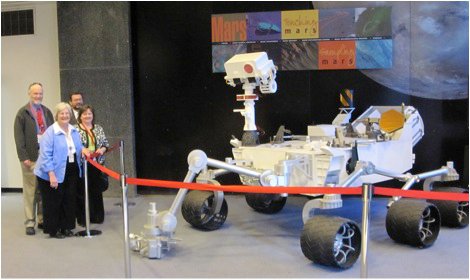
MAVEN results will have synergy with those from the Mars Science Laboratory (MSL). MSL will launch in just over a year, will land on the Martian surface, and will study the composition of the rocks, the soil, and the atmosphere. MAVEN and MSL both are focusing on Martian habitability, but from very different perspectives. Let me give an example of how results from the two missions can be used together.
MAVEN will measure the abundances of stable isotopes in the upper atmosphere and determine their relative escape rates. As an example, Deuterium (D) is the same composition as Hydrogen (H), but also has a neutron on the nucleus and is twice as heavy. Because D is heavier, it is lost from the top of the atmosphere to space less readily than H; as gases escape, the ratio of D/H in the gas remaining behind increases. Similarly, 16O is lighter than 18O and will be lost more easily, and the H2O or CO2 remaining behind in the atmosphere becomes enriched in the heavier isotope; the ratio of 18O/16O will become larger. The same will hold for 13C/12C or 15N/14N. This type of enrichment is a really good indicator that loss to space has occurred. MAVEN will determine the relative abundances of the different isotopes in the present-day upper atmosphere and how much more readily the lighter isotope can escape to space. From this, we can derive an estimate of the total amounts of each gas that have been lost to space.
MSL will measure the same ratios in gas at the bottom of the atmosphere (and results from Phoenix on a subset of the important gases and isotopes were just released). This will connect up directly with the MAVEN measurements at the top of the atmosphere and will allow an integrated look at the present-day atmosphere and escape processes. Perhaps more importantly, MSL also will sample rocks on the surface. The rocks are likely to contain minerals that have incorporated CO2 or H2O from the atmosphere, and measuring these materials will tell us about the atmosphere at those times in the past when the minerals formed. If the atmosphere had more of the heavier isotope when the minerals in the rock formed, then the minerals will show that same enhancement. By measuring these ratios in the minerals in the rocks, we may be able to infer the history of the atmosphere directly.
The Mars environment is a complex system. The atmosphere can exchange with gases that have been incorporated into rocks, it can exchange with ices in the polar caps, and it can exchange with gas at the top of the atmosphere where it can be lost to space. By measuring each different component of the system, we get a better understanding of the entire system. In fact, because of the complexity of the system, we must measure all of the different components of the system in order to understand how it works!

